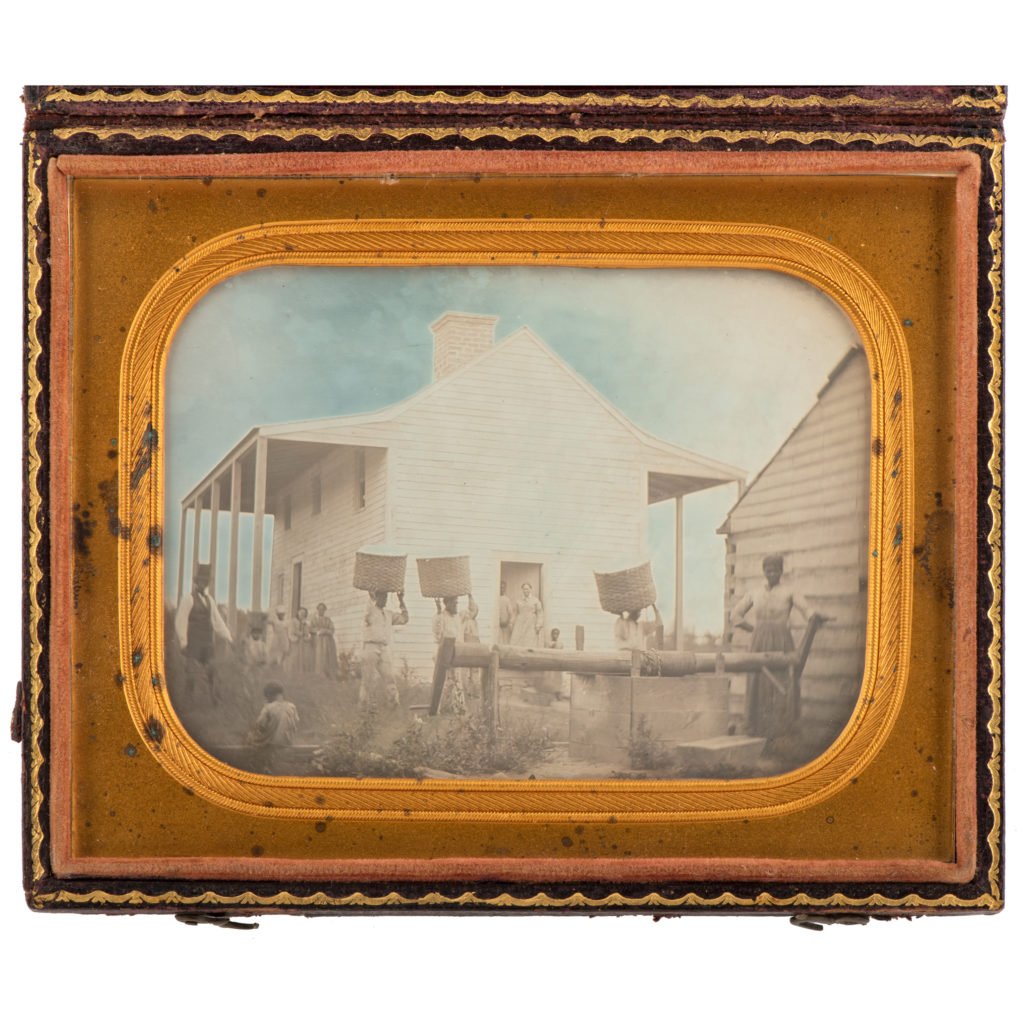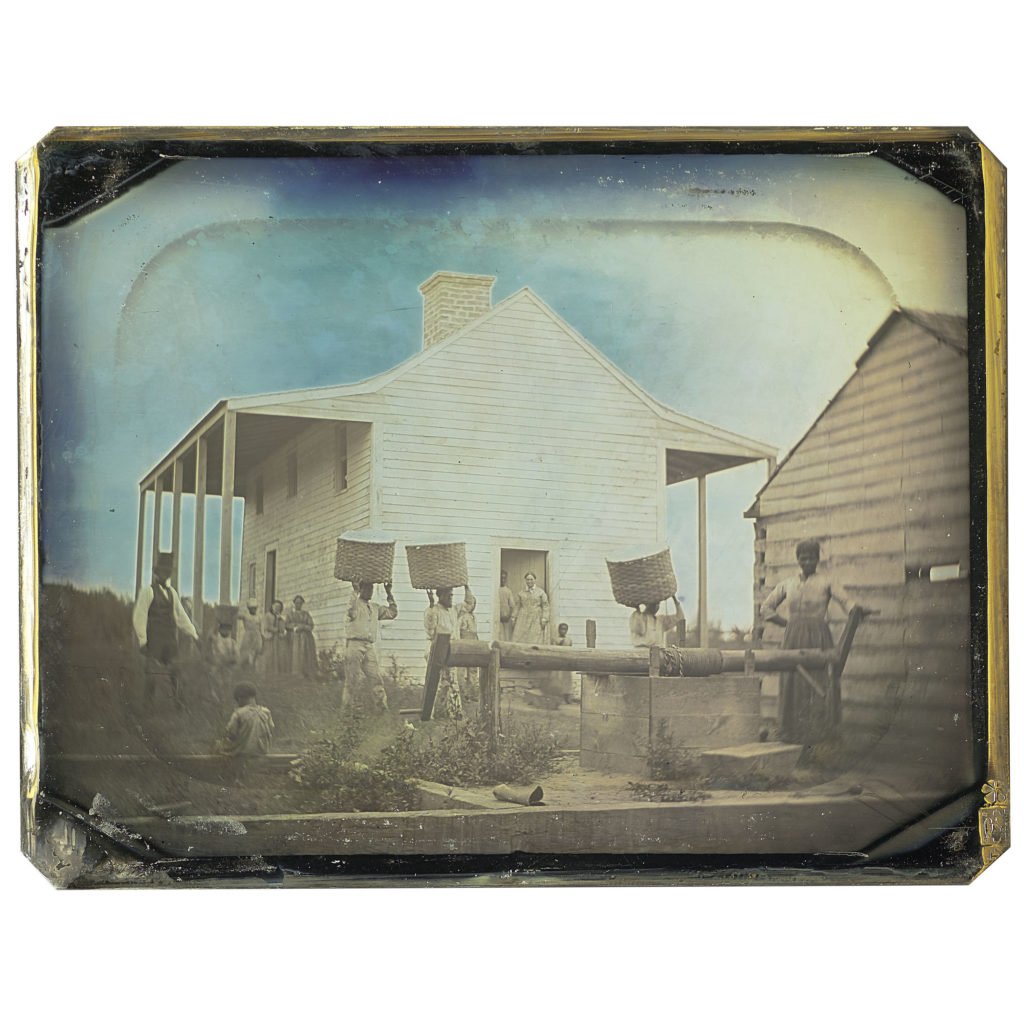Art World
This Is the Earliest Known Photograph of Slaves in the US—and It Challenges Our Understanding of History
The daguerreotype, acquired by the Nelson-Atkins Museum, depicts a middle-class Georgian man and nearly 10 slaves.

The daguerreotype, acquired by the Nelson-Atkins Museum, depicts a middle-class Georgian man and nearly 10 slaves.

Maxwell Williams

The Nelson-Atkins Museum in Kansas City, Missouri says they have acquired what is thought to be the earliest known photograph depicting slaves. Importantly, the image also challenges some popular notions about who generally owned slaves in the antebellum South.
The quarter-plate daguerreotype depicts what appears to be a slave owner and several enslaved men, women, and children standing outside of a small plantation building in Greene County, Georgia. Three of the enslaved men appear to be carrying large baskets of cotton above their heads.
The photograph was purchased in November from Cowan’s Auctions by the Hall Family Foundation (the philanthropic arm of the owners of Hallmark Greeting Cards and the Hallmark Channel) and gifted to the museum. The estimate for the image was between $100,000–150,000, but bidding for the rare photograph was furious, bringing the price up to $324,500.
The Cowan’s Auctions lot listing says that the photograph was discovered as part of the Austin, Texas estate of Charles Gentry Jr. (1958–2012), who had moved to Texas from Polk County, Georgia.
“Numerous Gentrys have resided in the areas around Polk, Hancock, and Greene Counties, and we suspect the daguerreotype was passed from Charles Gentry Sr. to his son,” the website states. “How Charles Sr. came to own the image is unknown, though presumably, it passed by descent through a member of his patrilineal line.”

The daguerreotype after restoration. Unknown maker, American. Slaves on cotton plantation, ca. 1850. Daguerreotype, quarter plate. Gift of the Hall Family Foundation.
With the name and possible locations as a clue, Cowan’s staff began to dig. They sent their research to historians from the Georgia Historical Society, the Georgia Historic Preservation Division, and the Georgia Trust for Historic Preservation, among other organizations, for comment and opinions. Soon, the Cowan’s staff was able to further narrow down the subject of the photograph.
The Cowan’s researchers went through the Federal Slave Schedules from 1850 to 1860, a federal census of slaves that also collected the names of slave owners. The slave owner pictured in the daguerreotype is likely Samuel T. Gentry. The census listed only a few Gentrys in Georgia, and Samuel Gentry was the only Gentry known to own at least 10 slaves. There appear to be at least that many slaves in the photograph.
The historians point out that the photograph is most important in that it shows that even middle-class Georgians owned slaves.
“The Gentry daguerreotype documents slavery in a far more humble setting than the large coastal plantations depicted in post-Civil War images taken by Samuel Cooley and other photographers who accompanied the Union Army,” the Cowan’s Auctions website states. “In these Sea Island plantations, hundreds of slaves were owned by a small class of planter elites, providing their families with access to luxuries only dreamed of by the vast majority of Georgians. While this is the vision most Americans have of the antebellum south, the Gentry daguerreotype depicts a different reality.”
, “This piece—a record of the historical crime of slavery—is remarkable both for the power of its content and for its technical and aesthetic sophistication,” said Keith F. Davis, senior curator of photography at the Nelson-Atkins, in a statement from the museum. “This is an unforgettable rendition of an era, and a way of life, that must never be forgotten or forgiven. At the same time, it markedly expands our understanding of the history of American photography. We have long believed that daguerreotypes such as this ‘should’ have been made in the 1850s; now we know that at least one actually was.”
Plans to display the image, perhaps in a broader context, are already in the works. The museum also intends to make the photograph available for loans.